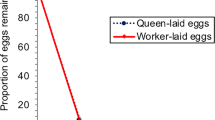Abstract
Sections of brood from colonies of the Cape honeybee ( Apis mellifera capensis), the African honeybee ( A. m. scutellata), and hybrid bees of the two races were exchanged between colonies to study the effect of different brood-origin/nurse-bee combinations on development of caste characters. When Cape larvae were raised by African workers the amount of food provided almost doubled in comparison with Cape larvae reared by their own workers. In contrast, African larvae raised by Cape workers were provided with only half the amount they received from their own workers. After the bees emerged, we found a large degree of plasticity in characters related to caste differentiation, which corresponded closely to the amount of food provided. Super-fed Cape bees had enlarged spermathecae, were heavier than normal workers and developed more rapidly, and had reduced pollen combs, all typical for a more queen-like condition. Ovariole numbers did not appear to be enhanced by additional feeding. Cape bees that behave as social parasites in African bee colonies were most queen-like in the characters studied, albeit within the range that was found for Cape bees from normal colonies, suggesting within-colony selection for characters that enhance reproduction.




Similar content being viewed by others
References
Allsopp MH (1993) Summarized overview of the Capensis Problem. S Afr Bee J 65:127–136
Allsopp MH, Hepburn HR (1997) Swarming, supersedure and the mating system of a natural population of honeybees ( Apis mellifera capensis). J Apic Res 36:41–48
Anderson RH (1963) The laying worker in the Cape honeybee, Apis mellifera capensis. J Apic Res 2:85–92
Arnold G, Le Conte Y, Troullier J, Hervet H, Chappe B, Masson C (1994) Inhibition of worker honeybee ovary development by a mixture of fatty acid esters from larvae. C R Acad Sci Paris 317:511–515
Beekman M, Calis JNM, Boot WJ (2000) Parasitic honeybees get royal treatment. Nature 404:723
Beetsma J (1979) The process of queen-worker differentiation in the honeybee. Bee World 60:24–39
Boot WJ, Calis JNM, Allsopp MH (2002) Social parasitism by the Cape honey bee. Proc Exp Appl Entomol NEV (Amsterdam) 13:103–107
Brouwers EVM (1984) Glucose/fructose ratio in the food of honeybee larvae during caste differentiation. J Apic Res 23:94–101
Hepburn HR, Crewe RM (1991) Portrait of the Cape honeybee, Apis mellifera capensis. Apidologie 22:567–580
Hepburn R, Radloff SE (2002) Apis mellifera capensis: an essay on the subspecific classification of honeybees. Apidologie 33:105–127
Hepburn HR, Nefdt RJC, Whiffler LA (1988) Queenloss in Cape honeybees: the interaction of brood, laying workers (false queens?) and queen cells. S Afr J Sci 84:778–780
Jay SC (1968) Factors influencing ovary development of worker honeybees under natural conditions. Can J Zool 46:345–347
Jay SC (1970) The effects of various combinations of immature queen and worker bees on the ovary development of worker honeybees in colonies with and without queens. Can J Zool 48:169–173
Jay SC (1972) Ovary development of worker honeybees when separated by worker brood by various methods. Can J Zool 50:661–664
Jay SC, Jay DH (1993) Effect of kiwifruit ( Actinidea deliciosa) and yellow flowered broom ( Cytisus scoparius Link) pollen on the ovary development of worker honey bees ( Apis mellifera L). Apidologie 24:557–563
Kryger P (2001) An obligate social parasite in honey bees: the pseudo-clone of Apis mellifera capensis. Proc 13th Entomol Congr S Afr, p 38
Kuwabara M (1947) Über die Regulation im weisellosen Volke der Honigbiene ( Apis mellifica), besonders die Bestimmung des neuen Weisels. J Fac Sci Hokkaido Univer 9:359–381
Le Conte Y, Sreng L, Poituot S (1995) Brood pheromone can modulate the feeding behaviour of Apis mellifera workers (Hymenoptera: Apidae). J Econ Entomol 88:798–804
Martin S, Wossler T, Kryger P (2002) Usurpation of African Apis mellifera scutellata colonies by parasitic Apis mellifera capensis workers. Apidologie 33:215–232
Mohammedi A, Paris A, Crauser Y, Le Conte Y (1998) Effect of aliphatic esters on ovary development of queenless bees ( Apis mellifera L). Naturwissenschaften 85:455–458
Moritz RFA, Kryger P, Allsopp MH (1996) Competition for royalty in bees. Nature 384:31
Neumann P, Hepburn R (2002) Behavioural basis for social parasitism of Cape honeybees ( Apis mellifera capensis). Apidologie 33:65–192
Onions GW (1912) South African 'fertile worker bees'. S Afr Agric J 1:720–728
Snodgrass RE (1956) Anatomy of the honey bee. Cornell University Press, New York
Williams IH, Free JB (1975) Effect of environmental conditions during the larval period of worker honeybees to develop their ovaries. J Entomol A 49:179–182
Wirtz P, Beetsma J (1972) Induction of caste differentiation in the honey bee ( Apis mellifera) by juvenile hormone. Entomol Exp Appl 15:517–520
Wossler TC (2002) Pheromone mimicry by Apis mellifera capensis social parasites leads to reproductive anarchy in host Apis mellifera scutellata colonies. Apidologie 33:139–163
Woyke J (1979) New investigations on Apis mellifera capensis. Apiacta 14:173
Woyke J (1999) Increased food supply to all larvae after dequeening honey bee colonies. J Apic Res 38:117–123
Acknowledgements
Willem Boot and Johan Calis are supported by the Netherlands Foundation for the Advancement of Tropical Research (WOTRO). They visited South Africa in November 2000 on a travel grant of the Netherlands Organisation for Scientific Research (NWO) and financial support by MITOX. Theresa Wossler is thanked for her help in obtaining Cape worker-laid brood from Pretoria and Louis van Niekerk is thanked for obtaining African honeybee colonies. Chris Fransman and Jhill Johns are thanked for dissections of sampled bees.
Author information
Authors and Affiliations
Corresponding author
Additional information
Communicated by R. Page
Rights and permissions
About this article
Cite this article
Allsopp, M.H., Calis, J.N.M. & Boot, W.J. Differential feeding of worker larvae affects caste characters in the Cape honeybee, Apis mellifera capensis . Behav Ecol Sociobiol 54, 555–561 (2003). https://doi.org/10.1007/s00265-003-0666-4
Received:
Revised:
Accepted:
Published:
Issue Date:
DOI: https://doi.org/10.1007/s00265-003-0666-4




